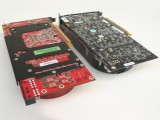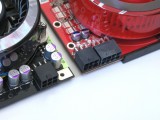After months of delays and much anticipation, ATI has finally come up with the Radeon HD 2900 XT, a DirectX 10 capable GPU meant to compete with Nvidia's GeForce 8 series, and the first big introduction in the PC enthusiast market since AMD acquired the company.
Indeed, it's no secret that ATI has had a lot of issues to work through over the past several months which has resulted in several delays of the now finalized 'R600' core design. The AMD acquisition created even more problems, and the fact they were developing a product that featured more transistors than any CPU currently in existence did not help their case much either.
Today we have in our hands a Radeon HD 2900XT board manufactured by ASUS, which is of course based on the R600 core using an 80nm design process. This version features just 512MB of onboard GDDR3 memory clocked at 1656MHz using a 512-bit wide memory bus. Combined with a core clock of 757MHz, the Radeon HD 2900XT can theoretically produce a memory bandwidth of 102.4GB/s, which is greater than that of the GeForce 8800 GTX.
 |
 |
|
 |
 |
In fact, on paper the Radeon HD 2900XT looks to be a more impressive product than the GeForce 8800 GTX is. Let's remember the GeForce 8 series brought a shift in GPU functionality and capability, moving away from the traditional pixel and vertex shaders we had got familiar with, to a collection of floating point processors also called Stream Processor Units (SPUs).
The 8800 GTX inner workings feature 128 SPUs clocked at 1.35GHz. Then we have TAUs (Texture Address Units) of which the 8800 GTX features 32, along with 24 ROPs (Rasterization Operator Units). The Radeon HD 2900XT, on the other hand, features a staggering 320 SPUs with 32 TAUs and just 16 ROPs.
The Radeon HD 2900XT looks so impressive on paper that we dare to say Nvidia did not want to be caught off-guard nor did it want to lose momentum with its GeForce 8 series boards that were selling quite well while it had no competition in the high-end graphics card market. Nvidia cunningly prepared a new product designed to stand up against the new Radeons. Known as the GeForce 8800 'Ultra', this new "overclocked" GTX features faster core and memory frequencies that marginally increase performance. But then again, if you have been following this competitive game of who holds the performance crowd, every bit helps.
Currently the average GeForce 8800 Ultra costs ~$800, while Nvidia claims this price should fall within the $700 mark in a fairly short period of time. Still this is quite a lot to pay when the average GeForce 8800 GTX costs 'just' $550, particularly given the Ultra is nothing more than an overclocked GTX. Nevertheless the GeForce 8800 Ultra is Nvidia's current flagship product and it is intended to take on the new Radeon HD 2900XT (right?).
Well not so fast, the Radeon HD 2900XT is said to retail for $400, making it significantly cheaper than the Ultra and even cheaper than the GTX. So, is the Radeon HD 2900XT targeting the 8800 GTX or the more affordable and less speedy 8800 GTS? Historically, GPU makers have always (or at least most of the time) launched their high-end parts first, selling for top dollar and aiming at big margins, apparently ATI/AMD have planned otherwise this time, or could it be the case that the R600 was uncapable of outperforming the GeForce 8800 GTX "on time"?
